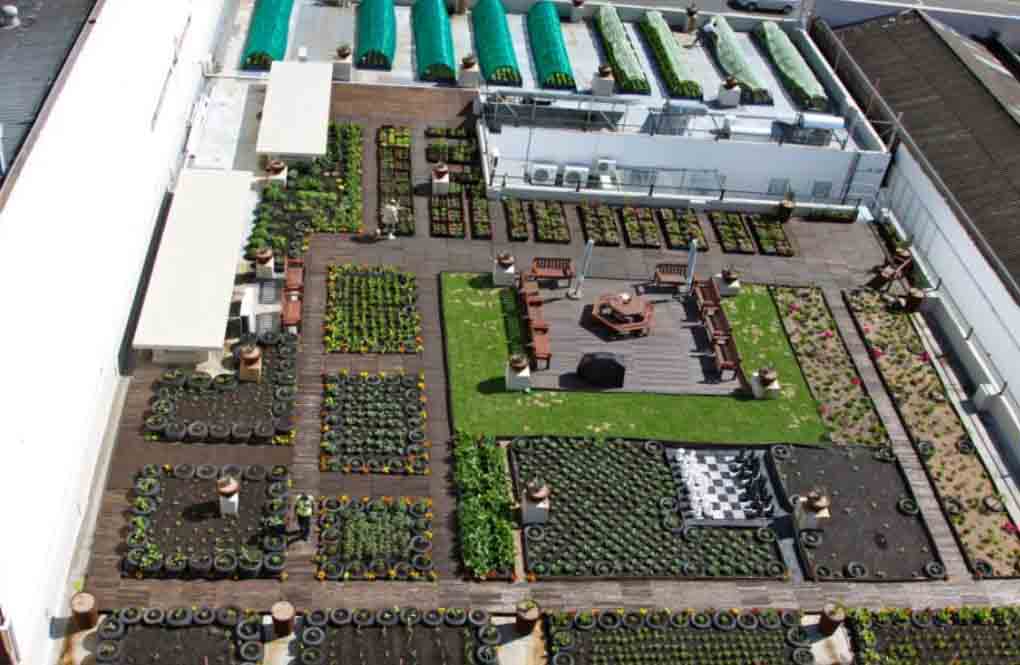Create a Rooftop Garden
Using rooftops to grow vegetables is an option for many city dwellers. Edible urban rooftops take previously sterile and unused areas and convert them into productive and healthy living spaces, reducing the eco-footprint of your home or office.

If you look out of your window right now you will probably see a roof you could use on a shed, a garage or a cottage. If you live in an apartment block, many have a flat top or a level section over the parking.
Before you start piling soil or placing boxes on your roof, there are some practical factors to take into consideration. Apart from the usual elements that go into any well-planned vegetable garden, a rooftop garden needs to allow for weight, safety, water flow, wind and access.
Weight bearing
Before beginning, consult a structural engineer to assess the roof. You might find certain areas can carry higher loads than others, or you might have to create a reinforcing framework. Once the loading capacity has been measured, a kilogram per square metre rate is given. Remember to calculate your garden in a ‘wet’ state as water is heavy. Choosing light materials will help keep the weight down.
Safety
Working on a rooftop to install a garden brings other challenges, such as safety. A balustrade is generally the cheapest method to ensure that there are no accidents. This needs to be installed before work can commence.
Access

Safe access to the rooftop is essential. For garden sheds and garage roofs a sturdy ladder will do, but for larger rooftops on taller buildings, if there is no ready access, stairs need to be installed.
Waterproofing
Flat roofs need a waterproofing system applied before construction can begin, such as the torch-on method - a heat-fused UV-stable membrane. If the roof already has one, ensure that there are no cracks that might compromise the waterproofing.
Drainage & Water flow
 The surface intended for your rooftop garden needs to be able to drain water off quickly as stationary water increases the risk of damp and adds to the loading weight. Understanding water flow is important when planning a rooftop garden. Although flat roofs look flat, they are designed for water to flow off them. The structural engineer will give you the percentage fall and anything greater than one per cent is good.
The surface intended for your rooftop garden needs to be able to drain water off quickly as stationary water increases the risk of damp and adds to the loading weight. Understanding water flow is important when planning a rooftop garden. Although flat roofs look flat, they are designed for water to flow off them. The structural engineer will give you the percentage fall and anything greater than one per cent is good.

Ascertain where the lowest point of the roof is and aim all the water in that direction. Ideally, install pathways in the natural path of the water flow, to assist water in exiting the garden. Wooden pallets and recycled plastic decking are ideal for pathways, which have a dual function of providing access to the beds and creating water channels, with the water flowing freely under the decking towards the drains.
Wind and Sun

On a rooftop – especially in coastal cities – wind can blow a garden to smithereens. To prevent this, choose low bushy plants and with taller ones, such as tomatoes, stake them well.
When creating permanent structures for seating, or pergolas for shade or support, design them to be wind permeable, otherwise they can create wind tunnels or be blown over.
Be Waterwise
Rooftops tend to dry out more quickly than a normal garden and a reliable water supply is important. Water-wise methods such as mulching, intensive planting and grouping all help a garden to survive the hot sun. For a larger garden, drip irrigation is ideal.
Planting
Bare rooftops can be very hot zones, but by simply planting a garden this is mitigated and a cooler environment is created. The beauty of rooftop gardens is what happens below them, In this Durban rooftop garden, the ambient temperatures inside the building below dropped by an average of 3 °C, reducing reduces the air conditioner use by 40 per cent during summer.
Want more like this? Go to:




